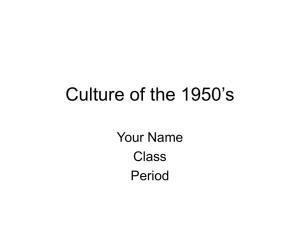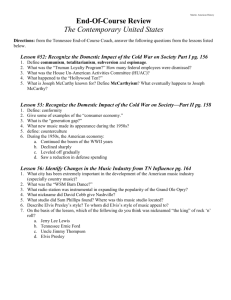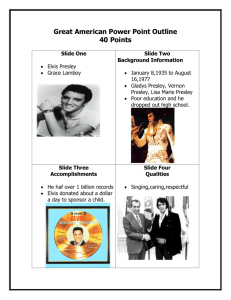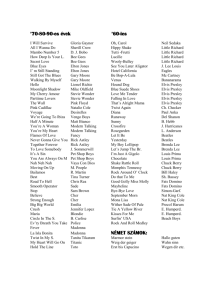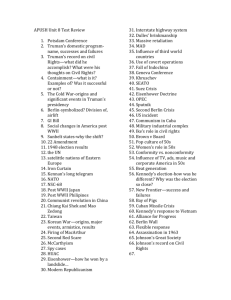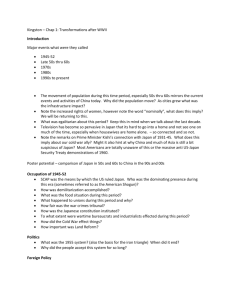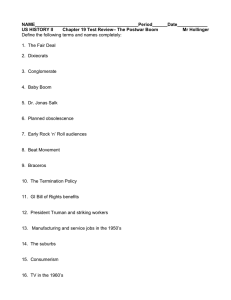Chapter 19 Section 2: The American Dream in the Fifties
advertisement
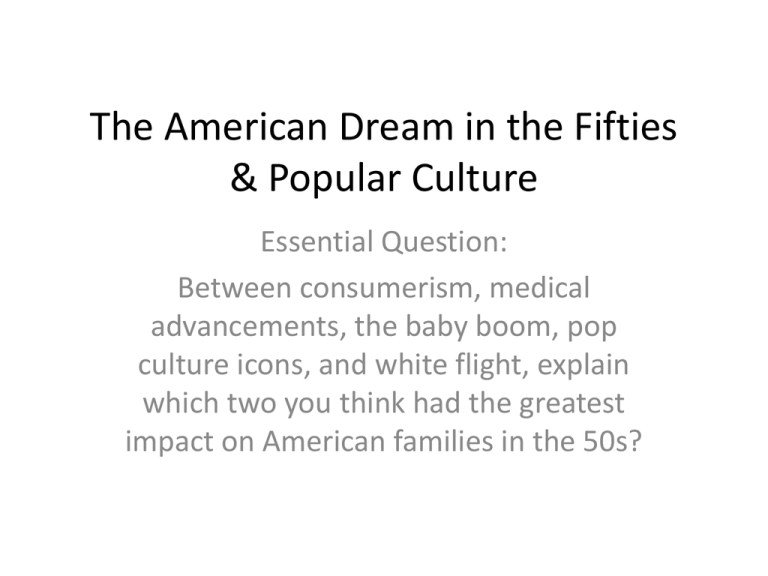
The American Dream in the Fifties & Popular Culture Essential Question: Between consumerism, medical advancements, the baby boom, pop culture icons, and white flight, explain which two you think had the greatest impact on American families in the 50s? The Organization and the Organization Man • The 1950s saw a great expansion in business • The majority of Americans went from having Blue Collar jobs to having White Collar jobs – Sales, advertising, accounting, managers, bankers, insurance, communication • Conglomerates – major corporation that includes a number of smaller companies in unrelated industries • Franchises – company that offers similar products or services in many locations • Standardized what people ate McDonald’s Social Conformity • The new work place was said to create “company people” – Loss of individuality – People (men) were given personality tests before they were hired to see if they “fit in” – Employees rewarded for teamwork, cooperation, and loyalty The Suburban Lifestyle • Most Americans worked in cities, but they no longer lived there • New highways, affordable cars, accessible gasoline • The most significant factor in suburban growth was the expanding interstate system • 13 million new homes were built in the 1950s, 85% in suburbs • This was the definition of the American Dream The Baby Boom • As soldiers settled back into homes after the war, there was an unprecedented explosion in the amount of babies being born • In 1957, one baby was being born every 7 seconds 10 million new students enrolled in elementary school in the 50s There was a major need for educational resources A new school opened every 7 days Advances in Medicine & the Miracle Drugs Drugs to fight and prevent childhood disease Dr. Jonas Salk developed a vaccine for the crippling effects of polio MMR vaccines given to children Parents were strongly encouraged to have their infants receive these shots to prevent these diseases What would the increasing use and availability of these drugs have on a population? It would increase the population because people live longer Leisure in the 50s • 40 hour work weeks with several weeks paid holidays/vacations • New household appliances like the washing machine, and dish washer meant less time spent doing chores • Americans had more leisure time than ever before – More than $30 million spent on leisure goods and activities in the 50s Leisure Activities of the 50s Automania! The Automobile Culture Because gas had been rationed during the war, there was a plentiful amount of petroleum making gas extremely cheap In addition, easy credit terms and low interest loans encouraged people to buy cars People had to travel to work in the cities from their suburbs The Interstate Highway System Shopping Centers, schools, cities to suburbs, all had to be linked together but how? The Interstate Highway System was signed by Eisenhower in 1956 – 41,000 miles Made high-speed long haul trucking possible With money, cheap gas, new highways, more leisure time, and available cars, it is no surprise that Americans took to the road in the 50s What is one downside of increased cars and road activity, despite new miracle drugs? Accidents and deaths Jobs move out of cities and into the suburbs Smaller towns were bypassed and cut off from consumers Consumerism Unbounds • Consumerism – the increased spending in consumer products • Any idea what the major new product that everyone had to have was? – The TV!!!! – over 90% of homes had at least one tv by 1970 – Also swimming pools, lawn mowers, grills, record players – Planned obsolescence – when manufacturers purposely designed products to become outdated in a short period of time – New models of products every year – kept spending up – Turned American into a “throwaway society” Popular Culture • Mass Media – communication that reaches large audiences • Television had reached 90% of American homes by 1960 • The Rise of Television – the Federal Communication Commission (gov’t agency that regulates and licenses tv, radio, and other broadcasts allowed 500 new stations to broadcast by 1956 Popular Television Show like father knows best showed women in inferior roles Rarely were any races other than white shown And western shows were feared to increase violence in youth Radio and Movies • Radio: – Did not want to compete with tv – Turned to local programming of news, weather, music, and community issues – Advertising rose by 35% • Movies: – Had to compete with tv also – In 1948, 18,500 movie theaters drew in 90 mil admissions per week – This number decreased by half because of tv – But this all changed with the introduction of COLOR! • The first full length film to use three-strip Technicolor was “The Wizard of Oz” (1939) Top Films of the 50s 1. The Ten Commandments 2. The Greatest Show on Earth 3. Lady and the Tramp 4. The High and Mighty 5. Abbot and Costello Meet Dr. Jekyll and Mr. Hyde 6. High Noon 7. Sunset Blvd. 8. On the Water Front 9. Dial M for Murder 10. Mister Roberts Top Songs of the 50s 1. 2. 3. 4. 5. 6. 7. 8. 9. ‘51 Mocking Hill – Patti Page ‘52 Unforgettable – Nat King Cole ‘53 That’s Amore – Dean Martin ‘54 Shake Rattle and Roll – Bill Haley and The Comets ‘55 Cherry Pink And Apple Blossom White – Perez Prado ‘56 Don’t Be Cruel – Elvis Presley ‘57 All Shook Up – Elvis Presley 58’ At the Hop – Danny and the Juniors 59’ Mack the Knife – Bobby Darin He’d just burst onto the stage from anywhere, and you wouldn’t be able to hear anything but the roar of the audience. He’d be on the stage, he’d be off the stage, he’d be jumping and yelling, screaming, whipping the audience on . . . Then when he did finally hit the piano and just went into di-di-di-di-di-di-di, you know, well nobody can do that as fast as _____. It just took everyone by surprise. - anonymous Who is this person referring to??? Little Richard! A Subculture Emerges The beat movement was a counterculture that existed from the 40s-60s and expressed the social and literary nonconformity of artists, poets, and writers The word “beat” originally meant “weary” but came to refer as well to a musical beat Followers of this movement were called beatniks and they shunned regular work and sought guidance through music and Zen Buddhism Many mainstream Americans found this lifestyle annoying and defiant African Americans & Rock ‘n’ Roll African music was only played on the African radio stations It took the interest of both gospel and jazz by some white men to blend and introduce a new style of music to the American people. Elvis Presley lived in Memphis and was exposed at an early age to gospel, he attended a black church. He also would follow some of the members of the congregation to bars at night where he fell in love with jazz and rhythm and blues. These influences all blended to form a type of music no one had ever heard – and he would be known as the King of Rock & Roll Elvis’s Influence on American Pop Culture • Read through the article about Elvis’s influence on American History • This was his first tv appearance and resulted in a frenzy of girls • His return appearance was conditional – only shot from chest-up. • Aloha from Hawaii is a music concert that was headlined by Elvis Presley, and was broadcast live via satellite on January 14, 1973. WSM Radio and Memphis Sun Records Exposure of National Event from TV • Not only did tvs and radios influence American popular culture, it also influenced politics and exposed major media events that changed the world – Ex: Some blame the televised debate between Nixon and Kennedy for Nixon’s loss – Ex: “That’s one small step for man, one giant leap for mankind” (who said this and what is it in reference too? • Neil Armstrong in 1960, landing on the moon Billy Graham’s Influence in Popular Culture During the 50s and 60s • We all know that Elvis was from Memphis • But there was another person who became the father of evangelicals from Tennessee and his name was . . . – Billy Graham – His revival meetings drew in hundreds of thousands to make “decisions for Christ” The Other America Just as some people were prospering in America, it did not mean that there was an absence of poverty and struggle for some. The Urban Poor • For many people, despite what pop culture may display on the outside, life did not live up to the “American Dream” • In 1962 – nearly one in every four Americans were living in poverty – Mainly elderly, single women and their children, and members of minority groups • White Flight – the process of middle class whites migrating to the suburbs taking with them part of the economy, and isolating minority groups in the inner cities – At the same time, African Americans filled the void migrating to the inner cities The Inner Cities • Each year, the federal government calculates the minimum amount of income it takes to raise a family of four – the poverty line is below this amount • In 2000 it was $17,601 • Can anyone guess what it was in 1959? – $2,973 • Urban Renewal – Was passed in 1949 to provide a “descent home and a suitable living environment for every American family” – Tear down rundown poverty stricken areas and redevelop them – As good as this may sound, the redevelopment was for shopping centers and other businesses and usually left families displaced Poverty Leads to Activism • Mexicans Seek Employment – During WWII, there was a need for Agriculture workers, congress establishes a program in 1942 that allowed Mexicans into the US to help harvest crops The Longoria Incident – Felix Longoria was a WWII hero – but he was MexicanAmerican – When his body was returned, the only undertaker in his hometown refused to provide funeral services Native Americans Continue Their Struggle • In 1944, Native Americans established the National Congress of American Indians • Had two main goals: 1. Ensure the same civil rights that whites had 2. Enable them to retain their own customs • In WWII over 65,000 Native Americans joined the service, and how were they repaid? – They stopped receiving family allotments and wages – Land that was taken while they were gone was not given back The Termination Policy • In 1953, the federal government announced that it would give up its responsibility for Native American tribes – termination policy – Eliminated federal economic support, discontinued the reservation system, and distributed tribal lands among individual Native Americans, and helped them settle in cities – Despite this, many Native Americans were discriminated against and were not given any jobs, medical care – In the end, the Termination Policy was terminated The American Dream in the Fifties & Popular Culture Answer the Essential Question: Between consumerism, medical advancements, the baby boom, pop culture icons, and white flight, explain which two you think had the greatest impact on American families in the 50s?
